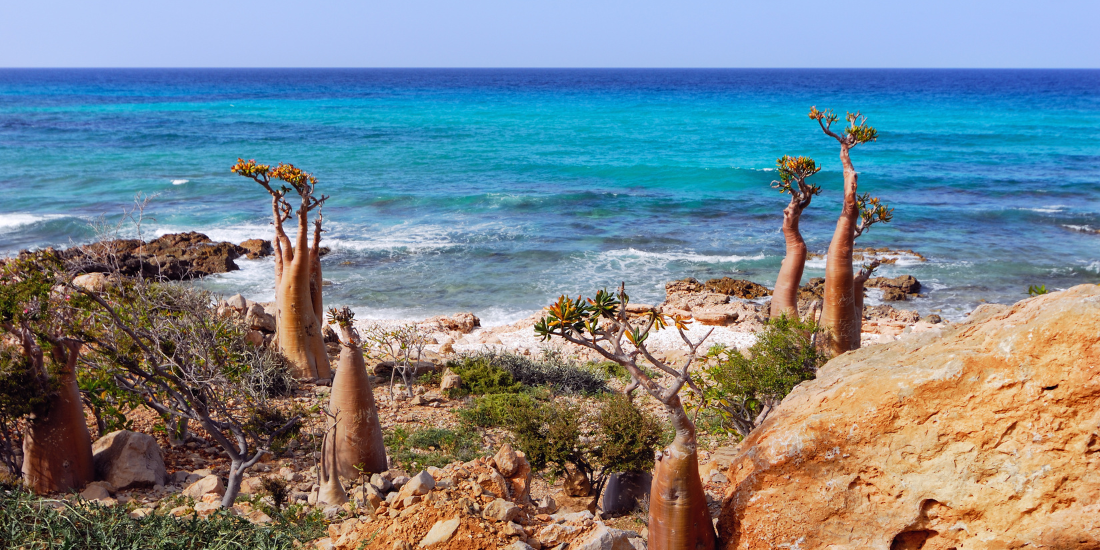Destination Guide: Socotra / Yemen
Socotra, often described as the jewel of biodiversity in the Arabian Sea, stands as a beacon of natural wonder. This remote island, part of an archipelago off the coast of Yemen, offers a unique travel experience for those seeking adventure, unparalleled natural beauty, and a step into a world that seems almost prehistoric. From its alien-like dragon blood trees to pristine beaches, Socotra is a dream destination for eco-tourists, nature lovers, and adventurous souls.
Highlights & Must-See Attractions
- Dragon Blood Trees: Socotra’s iconic dragon blood trees, with their umbrella-like canopies, are must-see. Their red sap, known for its medicinal properties, adds to their mystique.
- Dixam Plateau: Offering panoramic views of the dragon blood trees against the backdrop of rugged landscapes, the Dixam Plateau is perfect for hiking and photography.
- Detwah Lagoon: This stunning coastal lagoon boasts turquoise waters and is a fantastic spot for swimming, snorkeling, and camping under the stars.
- Homhil Plateau: Known for its biodiversity, including the frankincense trees, Homhil offers mesmerizing views and a natural pool for a refreshing dip.
- Qalansiyah Beach: A pristine beach that offers a tranquil escape, with soft white sands and clear waters, ideal for relaxation and beachcombing.
Our Lesser-Known Favourites
- Cave Explorations: Socotra is dotted with hidden caves, including Hoq Cave, which houses ancient inscriptions and stalactites and stalagmites formations.
- Birdwatching: With its unique avian population, Socotra is a birdwatcher’s paradise. Endemic species like the Socotra sunbird and the Socotra sparrow can be spotted.
- Traditional Socotri Villages: Experience the local culture by visiting traditional villages. The welcoming locals offer insights into their unique way of life.
- Ayhaft Canyon National Park: A lush oasis amid the arid landscapes, Ayhaft Canyon is home to endemic plants, natural pools, and diverse birdlife.
- Sand Dunes of Archer: Visit the impressive sand dunes that spill into the sea at Archer, offering a stunning contrast to the island’s mountainous terrain.
Did You Know?
Socotra is recognized as a UNESCO World Heritage Site due to its rich biodiversity. The island is home to hundreds of unique plant species that are not found anywhere else on Earth.
Socotra’s isolation has preserved its unique ecosystem and culture, offering a glimpse into a way of life that has remained unchanged for centuries.
Food and Cuisine
- Socotri cuisine is a blend of Yemeni and unique island flavors, with seafood being a staple.
- Dates and fresh fruits are commonly enjoyed, along with honey made from the island’s flowers.
- Traditional dishes often include goat meat, spiced rice, and flatbreads, offering a taste of the local agricultural practices.
Practical Information
- Best Season to Visit: The ideal time to visit Socotra is from October to April when the weather is milder and the seas are calm.
- Temperature: Temperatures range from 25°C to 35°C throughout the year, with humidity levels being relatively high.
- Visa Requirements: Visitors need visas in advance through an accredited operator as part of a travel package (SCN Travel & More being one of those).
Getting Ready for Departure
- Local Currency: Yemeni Rial (YER). It’s advisable to carry some cash (USD) as banking services are limited.
- Culture & Dress Code: Dress conservatively and respect local customs. Lightweight, modest clothing is suitable for the climate and cultural sensitivity.
- Language: Arabic is the official language, with Socotri spoken by the locals. English is understood in more touristic areas.
Souvenirs & Crafts
Consider bringing back frankincense, dragon blood tree sap products, and handwoven textiles as unique souvenirs that support the local economy and craftspeople.
Socotra offers an unforgettable journey into one of the world’s most isolated and enchanting natural wonders. Its blend of surreal landscapes, rich biodiversity, and warm local culture makes it a once-in-a-lifetime destination for the intrepid traveler seeking the road less traveled.


